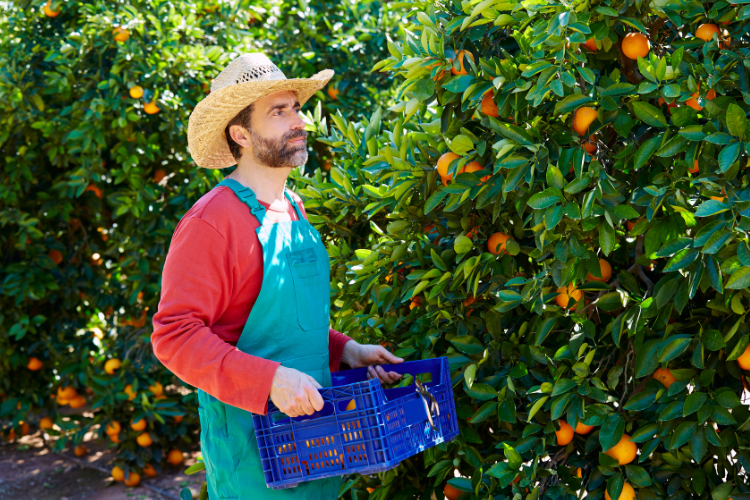Historic lows devastate Sunshine State agriculture.

Florida’s citrus industry just recorded its most catastrophic season in over a century. Picture walking through what were once thriving orange groves, now bearing the scars of relentless hurricanes and disease. The numbers tell a sobering story that reaches far beyond agriculture into the heart of Florida’s identity. According to the U.S. Department of Agriculture, the 2024-2025 growing season produced just 14.52 million boxes of citrus—the lowest total since the 1919-1920 season when 13.928 million boxes were harvested.
1. Hurricane Milton devastated 70% of productive acreage.

When Hurricane Milton made landfall in October 2024, it carved a destructive path directly through Florida’s citrus belt, including the most productive counties of Polk, Highlands, and Hardee. The Category 4 storm didn’t just bring wind and rain—it brought an economic catastrophe that agricultural experts estimate cost between $23 million and $55 million in citrus losses alone, according to the Florida Department of Agriculture and Consumer Services. Trees that had survived previous storms couldn’t withstand Milton’s relentless assault, with fruit dropping prematurely and branches snapping under sustained winds. What makes this particularly devastating is timing—Milton struck during the early harvest season when many varieties were ready for picking.
2. Orange production plummeted by 32.7 percent this season.

Growers managed to fill only 12.15 million boxes of oranges during the 2024-2025 season, representing a staggering one-third drop from the previous year. This decline becomes even more heartbreaking when you consider that farmers had been cautiously optimistic about grove recovery before the hurricanes hit. Valencia oranges, which typically account for the bulk of Florida’s juice production, saw production fall 38 percent compared to the previous season, as reported by the U.S. Department of Agriculture. The mathematical reality is stark: this year’s orange crop represents just 5 percent of what Florida produced during its peak season in 1997-98, when the state harvested 244 million boxes.
3. Citrus greening disease continues its relentless march.

While hurricanes grab headlines, a microscopic enemy has been quietly decimating Florida’s groves for two decades. Citrus greening, also known as Huanglongbing, spreads through a tiny insect called the Asian citrus psyllid and has now been detected in every commercial citrus-producing county in Florida. Trees infected with this bacterial disease experience premature fruit drop, produce unripe fruit, and eventually die—there’s no known cure, as discovered by researchers at the University of Florida’s Institute of Food and Agricultural Sciences. The disease forces growers to spend significantly more on grove management, therapeutic treatments, and tree replacement, costs that many smaller operations simply cannot sustain. Between citrus greening and hurricane damage, Florida has lost over 90 percent of its citrus production capacity since the early 2000s.
4. Grapefruit and specialty citrus suffered massive losses.

The devastation extended far beyond oranges, with grapefruit production tumbling 27.4 percent to just 1.3 million boxes. Tangerines and tangelos, though historically smaller crops, still experienced an 11 percent decline to 400,000 boxes. These specialty fruits often command higher prices at farmers markets and grocery stores, making their loss particularly painful for growers who depend on premium products to offset lower orange prices. Lemons, which were included in the official statistics for the first time this season, contributed 670,000 boxes to the total but couldn’t compensate for losses in other varieties.
5. Economic impact reaches billions in agricultural damage.

The financial toll extends far beyond individual farm losses, rippling through processing plants, transportation companies, and rural communities that have depended on citrus for generations. State authorities estimated that Hurricane Milton alone caused between $1.5 billion and $2 billion in total agricultural damage across Florida, with citrus representing a significant portion of those losses. When you factor in the ongoing costs of fighting citrus greening—including research, tree replacement, and grove management—the industry faces an unprecedented financial crisis. Many family operations that survived previous hurricanes are now considering whether they can afford to replant and rebuild.
6. Grove acreage continues shrinking under development pressure.

Even before hurricanes and disease struck, Florida’s citrus industry was losing ground to suburban sprawl and commercial development. Orange grove acreage has plummeted from 665,000 acres in 2000 to just 248,000 acres in 2024, according to USDA data. Grapefruit acreage tells an even more dramatic story, falling from 118,000 acres to 14,000 acres over the same period. When groves become unprofitable due to disease and storm damage, many owners find it more lucrative to sell to developers than to replant. This creates a devastating cycle: fewer productive groves mean higher per-acre pressure on remaining farms, making them more vulnerable to future catastrophes.
7. Climate change intensifies hurricane frequency and severity.

Scientists increasingly link the intensification of storms like Milton to warming ocean temperatures, which provide more energy for tropical systems to strengthen rapidly. The warming climate doesn’t just make individual storms more powerful—it’s changing the entire pattern of Atlantic hurricane seasons, potentially creating longer periods of storm activity. For citrus growers, this means planning for a future where Category 4 and 5 hurricanes may become more common rather than once-in-a-decade events. The industry must adapt to this new reality while simultaneously fighting disease and economic pressures that have already pushed many operations to the brink.
8. Price volatility creates uncertainty for consumers and growers.

Orange juice prices have reached near-record highs, with a 12-ounce can of frozen concentrate costing $4.31 according to Bureau of Labor Statistics data. Valencia oranges averaged $14 per box this season, up from $10.78 the previous year, while non-Valencia varieties jumped from $8.74 to $12.13 per box. These price increases reflect not just scarcity but also the higher costs of production in an industry under siege. However, volatile pricing makes it difficult for both farmers and consumers to plan ahead, creating additional uncertainty in an already unstable market.
9. Research offers hope through disease-resistant varieties.

Despite the grim statistics, scientists are making promising breakthroughs in developing citrus varieties that can resist both disease and environmental stress. Researchers are experimenting with genetic modifications, breeding programs, and innovative pest management techniques that could help trees survive both citrus greening and hurricane damage. Some experimental treatments have shown remarkable success, with one Argentine scientist reporting a 91 percent decrease in psyllid presence and 100 percent reduction in egg laying in treated groves. The challenge lies in scaling these solutions and getting them to farmers before more operations are forced to close permanently.
10. State legislators approve $124.5 million recovery package.

Recognizing the existential threat facing Florida’s citrus industry, the state legislature approved a substantial assistance package for the 2025-2026 fiscal year. Senate President Ben Albritton, who is himself a citrus grower from Wauchula, championed the funding that includes $100 million specifically for disease-resistant trees, grove management, and therapeutic tools. The investment represents more than just financial support, it’s a statement that Florida considers citrus essential to its agricultural identity and economic future. Whether this funding can reverse decades of decline remains to be seen, but it provides hope for an industry that has endured unprecedented challenges while continuing to supply nearly half of America’s orange juice production.
